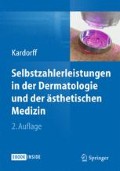Zusammenfassung
Messung des Hautzustandes durch Bestimmung von Hautfeuchtigkeit , Sebum , Transepidermalem Wasserverlust (TEWL), Elastizität , Oberflächenstruktur , Pigmentierung und Rötungsgrad sowie präzise Hautanalyse mit hochauflösendem Ultraschall. Der Patient wird miteinbezogen durch Demonstration seiner hautphysiologischen Parameter am Display des Kombi-Messgerätes DermaLab® Combo der Fa. Cortex Technology aus Dänemark. Die vielfältigen Möglichkeiten der wichtigen Untersuchung hautphysiologischer Parameter und der große Beratungsnutzen für den Patienten werden ausführlich vorgestellt.
Access this chapter
Tax calculation will be finalised at checkout
Purchases are for personal use only
Literatur
Hanau A, Stucker M, Gambichler T, Orlikov A, Hoffmann K, Altmeyer P, Freitag M (2003) Nichtinvasive Diagnostik von Hautfunktionen. Hautarzt 54(12) 121–1123
Zuang V, Rona C, Distante F, Berardesca E (1997) The use of a capacitance device to evaluate the hydration of human skin. J Appl Cosmetol 15: 95–102
Berardesca E, Distante F (1996) Bioengineering: methods. In: Van Der Valk PGM, Maibahc HI [eds.]: The irritant contact dermatitis. Boca Raton New York London Tokyo, CRC Press: 313–316
Fartasch M, Bassukas ID, Diepgen T (1993) Structural relationship between epidermal lipid lamellae, lamellar bodies and desmosomes in human epidermis: an ultrastructural study. Br J Dermatol 128(1): 1–9
Fartasch M, Hüner A, Tepe A, Funke U, Diepgen TL (1993) Hautphysiologische Untersuchungsmethoden in der Berufsdermatologie. Allergologie 16: 25–34
Fiedler F, Werle E (1968) Activation, inhibition, and pH-dependence of the hydrolysis of alpha-N-benzoyl-L-arginine ethyl ester catalyzed by kallikrein from porcine pancreas. Eur J Biochem 7(1):27–33
Raab W, Kindl U, Daniels R (1999) Pflegekosmetik- Ein Leitfaden, Wissenschaftliche Verlagsgesellschaft mbH Stuttgart
Fluhr JW, Mao-Qiang M, Brown BE, Wertz PW, Crumrine D, Sundberg JP, Feingold KR, Elias, PM (2003) Glycerol regulates stratum corneum hydration in sebaceous gland deficient (asebia) mice. J. Invest. Dermatol 120:728–737
Stewart M (1992) Sebaceous glands lipids. Seminars Dermatol 11:100–105
Wille J, Kydonieus A (2003) Palmitoleic acid isomer (C16: 1D6) in human skin sebum is effective against GRAMpositive bacteria. Skin Pharmacol Appl Skin Physiol 16:176–187
Freeman S, Maibach H (1988) Study of irritant contact dermatitis produced by repeat patch test with sodium lauryl sulfate and assessed by visual methods, transepidermal water loss and laser doppler velocimetry. J Am Acad Dermatol 19:496–502
Elsner P, Wilhelm D, Maibach HI (1990) Frictional properties of human forearm and vulvar skin: Infuence of age and correlation with transepidermal water loss and capacitance. Dermatologica 181:88–91
Cua AB, Wilhelm KP, Maibach HI (1990) Frictional properties of human skin: relation to age, sex and anatomical region, stratum corneum hydration and transepidermal water loss. Br J Derm 123:473–479
Lodén M, Olssen H, Axell T, Linde YW (1992) Friction, capacitance and transepidermal water loss (TEWL) in dry atopic and normal skin. Brit J Derm 126 (2):137–141
Scott RC, Oliver GJA, Dugard PH, Singh HJ (1982) A comparison of techniques for the measurement of transepidermal water loss. Arch Dermatol Res 274:57
Tagami H, Kobayashi H, Kikuchi K (2002) A portable device using a closed chamber system for measuring transepidermal water loss: comparison with the conventional method. Skin Res Technol 8:7
Tupker RA, Pinnagoda J (2006) Measurement of Transepidermal Water Loss by Semiopeb Systems. In Serup, J (ed) Handbook of Non-invasive methods and the skin. CRC Press
Nilsson GE (1977a) On the measurement of evaporative water loss. Methods and clinical applications. Thesis, Linköping University Medical Dissertations No. 48. Linköping, Schweden
Nilsson GE (1977) Measurement of water exchange through skin, Medical and Biological Engineering and Computing 15(3):209–218, 1977-05–01, DOI: 10.1007/BF02441040
Nishi Y, Gagge AP (1977) Effective temperature scale useful for hypo- and hyperbaric environments. Aviat Space Environ Med 48(2):97–107
Pinnagoda J, Tupker RA, Anger T, Serup J (1990) Guidelines for transepidermal water loss (TEWL) measurement. Contact Dermatitis 22:164–178
Purslow PP, Wess TJ, Hukins DW (1998) Collagen orientation and molecular spacing during creep and stress-relaxation in soft connective tissues. J Exp Biol 201:135–142
Wilhelmi BJ, Blackwell SJ, Mancoll JS, Phillips LG (1998) Literaturverzeichnis 309 Creep vs. stretch: a review of the viscoleastic properties of skin. Ann Plast Surg 41(2):215–219
Sasaki N, Odajima S (1996) Stress-strain curve and Young’s modulus of a collagen molecule as determined by the X-ray diffraction technique. J Biomech 29 (5): 655–658
Hsu S, Jamieson AM, Blackwell J (1994) Viscoelastic studies of extracellular matrix interactions in a model native collagen gel system. Biorheology 31(1):21–36
Berardesca E, Farinelli N, Rabbiosi G, Maibach HI (1991) Skin Bioengineering in the Noninnvasive Assessment of Cutaneous Aging. Dermatologica 182:1–6
Randazzo SD, Dinotta (1993) Dry Skin: Pathophysiology and Treatment. J Appl Cosmetol 11:121–126
Strianse SJ (1978) Human skin - moisturizing mechanism and natural moisturizers. Cosmet & Toilet 93:37–41
Fullerton A, Fischer T, Lahti A, Wilhelm KP, Takiwaki H, Serup J (1996) Guidelines for measurement of skin colour and erythema. A report from the Standardization Group of the European Society of Contact Dermatitis. Contact Dermatitis 35:1–10
Author information
Authors and Affiliations
Editor information
Editors and Affiliations
Rights and permissions
Copyright information
© 2015 Springer-Verlag Berlin Heidelberg
About this chapter
Cite this chapter
Steinert, M. (2015). Hautphysiologische Parameter als Beratungstool und Unterstützung bei Verkaufsgesprächen: Zeigen Sie Ihrem Patienten, was in ihm steckt!. In: Kardorff, B. (eds) Selbstzahlerleistungen in der Dermatologie und der ästhetischen Medizin. Springer, Berlin, Heidelberg. https://doi.org/10.1007/978-3-662-43427-7_10
Download citation
DOI: https://doi.org/10.1007/978-3-662-43427-7_10
Published:
Publisher Name: Springer, Berlin, Heidelberg
Print ISBN: 978-3-662-43426-0
Online ISBN: 978-3-662-43427-7
eBook Packages: Medicine (German Language)

